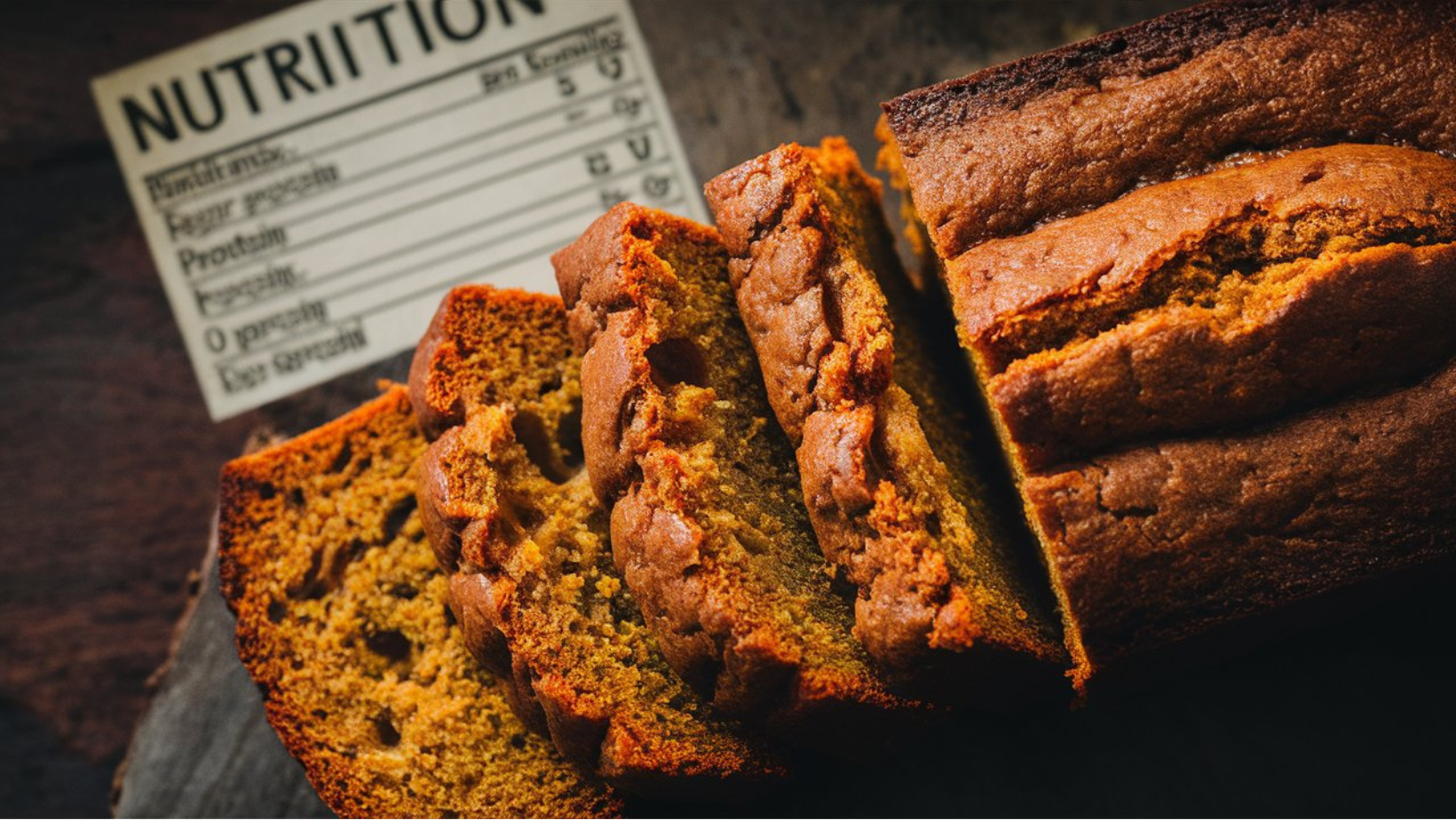Introduction to the Nutritional Insights of Pumpkin Bread
When the leaves start to change, and the air gets a bit crisper, many of us reach for the comforting flavors of fall, among which pumpkin bread stands out. This beloved treat is not only delicious but prompts curiosity about its nutritional content, particularly its protein value. How much protein is actually in pumpkin bread, and how does it stack up in a balanced diet? Let’s slice into the details and uncover the nutritional profile of this seasonal favorite.
Introduction to Pumpkin Bread and Its Nutritional Inquiry
Pumpkin bread, a staple in autumnal baking, tantalizes the taste buds with its spicy, sweet flavors. But beyond its delightful taste, considering its nutritional aspects, especially the protein content, becomes crucial for those mindful of their dietary intake. Indeed, pumpkin bread offers more than just a treat for the senses—it can also be part of a nutritious diet.
Why Focus on Protein in Pumpkin Bread?
Protein is an essential macronutrient vital for building muscles, repairing tissues, and making enzymes and hormones. Understanding the protein content in pumpkin bread can help individuals tailor their diet more effectively, ensuring they meet their nutritional needs without compromising on flavor. Additionally, for those involved in dietary planning, such as individuals following vegan or high-protein diets, knowing the exact protein content can aid in making informed dietary choices.
How Pumpkin Bread Fits into Various Diets
Moreover, pumpkin bread’s versatility allows you to adapt it to various dietary restrictions. Whether you’re crafting a gluten-free loaf or a vegan-friendly version, you can modify pumpkin bread to fit dietary needs while still providing essential nutrients. This adaptability makes it a fantastic option for diverse dietary plans, enhancing its appeal during the festive season and beyond.
In the next section, we’ll dive deeper into the nutritional makeup of pumpkin bread, examining its calorie, carbohydrate, and fat content, and spotlight how it fits into a health-conscious diet. By understanding these elements, we can appreciate not just the taste but the substantial benefits that pumpkin bread can offer.
Detailed Nutritional Profile of Pumpkin Bread
Pumpkin bread is more than just a delightful treat; it’s a complex amalgamation of various nutrients that contribute to its overall nutritional value. Let’s break down the components to understand what exactly goes into a typical slice of this seasonal bread.
Calories and Macronutrients
Starting with the basics, a standard slice of pumpkin bread can vary in calories, but it typically hovers around the 200-calorie mark. This energy comes from a combination of carbohydrates, fats, and proteins. The majority of the calories in pumpkin bread are derived from carbohydrates, usually around 30 grams per slice, making it a significant source of energy.
- Carbohydrates: Essential for energy, they are predominantly present in the form of sugars and starches in pumpkin bread.
- Fats: A slice contains about 6 grams of fat, which contributes to the bread’s moist texture and rich flavor.
- Protein: Often overlooked, protein in pumpkin bread averages about 3 grams per slice, which might seem modest but is significant for those tracking their protein intake.
Vitamins and Minerals
Besides macronutrients, pumpkin bread is a modest source of several vitamins and minerals, enhancing its nutritional profile:
- Vitamin A: Thanks to the pumpkin puree, the bread is a good source of Vitamin A, essential for vision and immune function.
- Iron: Contributing to the production of red blood cells, iron is another nutrient found in this bread, albeit in small amounts.
Each nutrient plays a pivotal role, and by understanding these contributions, we can appreciate the health benefits that pumpkin bread offers beyond its delightful taste.
Protein in Pumpkin Bread
Pumpkin bread is a seasonal favorite known for its spices and sweetness, but it also contains essential protein. Let’s examine the protein content in pumpkin bread and compare it to other popular baked goods.
How Much Protein Does Pumpkin Bread Contain?
A typical slice of pumpkin bread has about 2 to 3 grams of protein. This contribution is modest but valuable for daily nutrition. The protein mainly comes from the flour and eggs used in the recipe. Adding ingredients like nuts or protein-rich yogurt can increase this amount.
Comparison With Other Breads
Compared to other types of bread, pumpkin bread is not the highest in protein. Whole grain or seeded breads often have twice the protein of pumpkin bread. However, it is comparable to other sweet breads like banana or zucchini bread, which have similar protein levels. This makes pumpkin bread a decent option for those balancing indulgence with nutritional value.
Understanding the protein content helps position pumpkin bread within dietary choices. It assists those monitoring their macronutrient intake for health or fitness reasons.
How to Increase the Protein Content in Pumpkin Bread
For those looking to boost the protein in pumpkin bread, several recipe tweaks can help enhance its nutritional profile. Here’s how you can add more protein to your homemade pumpkin bread.
Ingredients That Boost Protein
Boosting the protein content in pumpkin bread can be simple with the right additions:
- Greek Yogurt: Mix Greek yogurt into the batter to significantly up the protein while keeping the bread moist.
- Nuts and Seeds: Add almonds, walnuts, flaxseeds, or chia seeds for extra protein, healthy fats, and fiber.
- Protein Powder: Incorporate a scoop of your preferred protein powder to increase protein without much change in flavor.
Recipe Adjustments for Higher Protein
Modifying your pumpkin bread recipe to include more protein is straightforward and need not compromise flavor or texture:
- Replace Some Flour: Use almond flour or another nut-based flour instead of some regular flour to boost protein.
- Add Egg Whites: Include more egg whites in the recipe for additional protein without extra fat.
- Consider Legume Flours: Chickpea flour and other legume flours can also enhance the protein content and add a distinct flavor.
These simple ingredient additions and recipe changes can make traditional pumpkin bread richer in protein. These adjustments not only improve nutritional value but also let you enjoy this fall favorite with less dietary concern.
Is Pumpkin Bread Suitable for Your Diet?
Pumpkin bread can be a delightful addition to various dietary plans. It’s essential to consider how it fits within specific dietary restrictions and preferences. Whether you’re adhering to a vegan, gluten-free, or another specialized diet, there are ways to adapt pumpkin bread recipes to meet your needs.
Vegan and Gluten-Free Variations
For those following a vegan diet, pumpkin bread can easily be adapted to exclude animal products:
- Vegan Substitutions: Use flax eggs instead of regular eggs, plant-based milk, and vegan butter or oil.
- Sweetener Choices: Opt for vegan-friendly sweeteners like coconut sugar or agave nectar.
For individuals with gluten sensitivities or celiac disease, making pumpkin bread gluten-free is straightforward:
- Gluten-Free Flours: Use gluten-free flours such as almond flour, oat flour, or a pre-mixed gluten-free blend.
- Xanthan Gum: Add xanthan gum to replace the elasticity and texture that gluten provides.
Pumpkin Bread in a Balanced Diet
Pumpkin bread can also play a role in a balanced diet when consumed in moderation:
- Moderation is Key: Although nutritious, pumpkin bread is calorie-dense and should be eaten in moderation.
- Nutrient-Dense Ingredients: Adding ingredients like pumpkin puree, nuts, and seeds can increase the bread’s health benefits.
By understanding these dietary adaptations, you can enjoy pumpkin bread in a way that aligns with your health goals and dietary restrictions. This flexibility makes pumpkin bread a versatile choice for many, enhancing its appeal during the holiday season and beyond.
Frequently Asked Questions
Pumpkin bread is a subject of many queries, especially regarding its nutritional aspects and how it fits into various diets. Here are some frequently asked questions that shed light on common concerns and provide valuable insights into this popular autumnal treat.
What is the best way to store pumpkin bread to maintain its freshness?
To keep pumpkin bread moist and fresh, wrap it tightly in cling film or store it in an airtight container. It can be kept at room temperature for a few days or refrigerated to extend its shelf life for up to a week. For longer storage, pumpkin bread freezes well. Simply slice it before freezing and wrap each slice individually for easy thawing.
Can pumpkin bread be considered a healthy snack?
Pumpkin bread can be part of a healthy diet when consumed in moderation. It typically contains pumpkin puree, which is rich in vitamins and fiber. However, store-bought or traditional recipes may also be high in sugars and fats. Opting for homemade versions where you can control the ingredients, such as reducing sugar and incorporating whole grains and nuts, can enhance its nutritional profile.
How can I make pumpkin bread moister?
To achieve a moister pumpkin bread, ensure not to overbake it, as this can dry it out. Adding moisture-rich ingredients like applesauce, yogurt, or extra pumpkin puree can also help keep the bread soft and moist. Using brown sugar instead of white sugar can contribute to a moister texture due to its higher moisture content.
These questions highlight the versatility and adaptability of pumpkin bread, making it a favorable option for many who enjoy baking and indulging in seasonal treats. Each answer provides further understanding and practical tips for enhancing your baking experience and enjoyment of pumpkin bread.
In the concluding section, we will summarize the main points covered in this article and offer a final assessment of the nutritional value of pumpkin bread, especially focusing on its protein content.
Summary and Final Thoughts on Pumpkin Bread’s Protein Content
As we conclude our discussion about pumpkin bread, it’s clear that this favorite fall treat provides more than just delightful flavors; it offers nutritional benefits, particularly in terms of protein. Here are the key points and a final perspective on the nutritional role of pumpkin bread.
Pumpkin bread is celebrated for its sweet, spiced flavor, emblematic of autumn. It also packs essential nutrients that support a healthy diet. While each slice has a modest protein amount, it can contribute to daily nutritional needs. The bread’s versatility makes it adaptable to various dietary needs, enhancing its appeal during the festive season.
Furthermore, you can enhance pumpkin bread’s protein content by adding ingredients like nuts, seeds, and protein powders. These additions not only increase its nutritional value but also allow customization to meet specific dietary goals.
Pumpkin bread can also fit into a balanced diet when enjoyed in moderation. Its components are rich in vitamins and minerals, offering significant health benefits. This makes pumpkin bread a beneficial choice for those mindful of their health.
In short, pumpkin bread transcends its role as a seasonal treat. It is a flexible bakery item that can be modified to improve its health benefits, showing that traditional treats can be nutritious and delightful. Enjoy pumpkin bread wisely, knowing it offers benefits for both the soul and the body.

